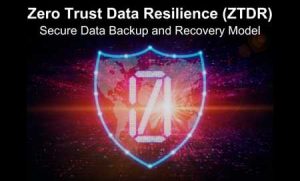Numberline Security and Veeam Extend Zero Trust Maturity Model for Improved Cyber Resilience
Model to help organizations reduce risk of growing data security threats and improve their overall resilience
This is a Press Release edited by StorageNewsletter.com on December 5, 2023 at 2:01 pmVeeam Software, Inc. introduced Zero Trust Data Resilience (ZTDR), a model to help organizations reduce the risk of growing data security threats and improve their overall resilience.

(Image from Numberline Security)
Developed in collaboration with Jason Garbis, Zero Trust expert, Numberline Security, ZTDR applies Zero Trust principles to backup and recovery as an extension to the Cybersecurity and Infrastructure Security Agency (CISA) Zero Trust Maturity Model. Essential to ZTDR is the separation of backup management systems and their storage tiers into distinct resilience zones to reduce the attack surface and limit the potential blast radius from breaches; and immutable backup storage, to ensure that data cannot be modified even in the event of a ransomware attack.
Modern, effective security is based on Zero Trust, replacing the increasingly ineffective perimeter-based security approach. Yet most Zero Trust frameworks do not include the security of data backup and recovery systems, despite the fact backup data is often the primary target of malicious actors in both ransomware and data exfiltration attacks. The Veeam Data Protection Trends Report 2023 found 93% of ransomware attacks are targeting backup repositories.
“Backup infrastructure by its nature has a large attack surface, because it must have read and write access to production, spanning virtually all enterprise applications and data sources, both on-premises and in the cloud,” said Jason Garbis, founder, Numberline Security. “To reduce that risk, Numberline and Veeam are proposing practical ZTDR tools, including core principles, an architecture, and a maturity model. Our goal is to help organizations fill a gap in their security strategy by extending Zero Trust to backup and recovery to achieve greater cyber resilience.”
Within the CISA Zero Trust Maturity Model, ‘Data’ is 1 of 5 pillars, under which it identifies 5 key functions: data inventory management, data categorization, data availability, data access and data encryption.
To extend this model to critical function of data backup and recovery, ZTDR principles are:
- Least privilege access
- Immutability
- System resilience
- Proactive validation
- Operational simplicity
To help organizations begin their journey to implement these principles, Numberline has developed a detailed ZTDR Maturity Model, as well as a ZTDR Reference Architecture which includes these key attributes for improved data resilience:
- Segmentation, for separation of backup software and backup storage layers to create distinct resilience zones that minimize the attack surface and reduce the blast radius when an attack occurs.
- Backup storage immutability, ensuring data cannot be modified or deleted.
“The latest Veeam research shows that 75% of ransomware attacks on backups are successful,” said Danny Allan, CTO, Veeam. “To keep businesses running, it’s essential to ensure data immutability and to follow best practices like ZDTR. With the ZTDR Maturity Model, every organization can chart their path to greater data security and less down time. While Veeam has always been committed to this architectural approach, we are working with storage partners to implement an industry leading zero trust model.”
“To combat escalating cyber threats like ransomware, there is a pressing need to unify and strengthen IT and security effectiveness leveraging frameworks like Zero Trust,” said Christophe Bertrand, practice director, ESG. “We have found in our latest ransomware state of the market research that 86% overall think Zero Trust is a key strategy for ransomware protection. ZTDR is fundamental in addressing those needs to deliver a more robust security posture through faster and safer recovery.”
Resources :
The full Zero Trust Data Resilience model, core principles, recommended architecture and maturity model free
Resilience: Why Data Backup and Recovery Matter













 Subscribe to our free daily newsletter
Subscribe to our free daily newsletter


